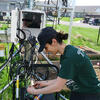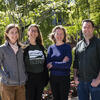The Promise of Agrivoltaics: Food Made in the Shade
When the Philadelphia region baked in high heat and humidity last July, lettuce and spinach growing in an open field at the Temple Ambler Campus withered away. However, the same plants grown nearby, underneath the shade of solar energy panels, thrived—even though they received only half the water the other plants did.
“Growing lettuce and spinach in the summer is otherwise impossible but, if you can manipulate the microclimate, the produce you grow has a much higher sales value,” says Sujith Ravi, associate professor, in the Department of Earth and Environmental Science.
That is just one example of the potential for agrivoltaics—an emerging field that Ravi has helped pioneer. It combines producing much-needed solar energy on agricultural or range lands to improve land use and address food-energy-water challenges in an increasingly warmer world.
“It doesn’t work well with every climate and crop,” says Ravi. “Yet it’s a powerful idea. Where it’s either too hot or there’s too much sunlight, we’re experimenting to determine if growing plants underneath solar panels can expand both growing seasons and viable agricultural acreage.”
Since his 2014 arrival at the College of Science and Technology, Ravi and his team of researchers and students have explored co-locating solar energy devices with crops and/or biofuels, grazing and/or pollinator-friendly native plants at multiple sites around the world, including the United States, India, Indonesia and Nepal.
The team has produced more than 10 influential publications, including some of the earliest U.S. studies. The most recent is a data-driven global analysis, led by graduate student Caroline Merheb, published this summer on the cover of Nature Sustainability that underscores both the potential and importance of tailoring agrivoltaics to local conditions. Another graduate student, Pralad Phuyal, is conducting research related to agrivoltaics in Nepal.
As a key partner in the U.S. Department of Energy’s InSPIRE project, Ravi’s laboratory participated as co-authors, with the lead National Renewable Energy Laboratory, to write the first DOE agrivoltaics technical report. Its insights garnered national attention and helped pave the way for the new discipline.
For this work, five years ago Ravi was awarded a National Science Foundation CAREER Award—one of the most prestigious accolades for early-career faculty.
Currently, ongoing studies at eight 40- to 100-acre solar power plants in Minnesota are yielding good results when sheep periodically graze on dozens of deep-rooted pollinator-friendly plant species—including grasses, asters and sunflowers. The depleted soils have been heavily cultivated since the mid-1800s. Yet in just six to seven years, sensors indicate that the plants growing under the solar arrays are storing more carbon and nutrients, microbial activity has improved and less water is needed. More insects are also being attracted to pollinate crops.
Ravi spent his 2024-25 sabbatical at the Politecnico di Milano in Milan, Italy, refining models to predict what those results could be in 50 years.
Since 2023, Ravi’s team at Temple Ambler has also been analyzing two 50-meter-square test plots (open sky vs. underneath solar panels)—Pennsylvania’s only such dedicated site for crop production. Multiple site-specific factors are affecting success, including which crops are grown. Leafy vegetables, some varieties of radishes and stringless beans had superior yields under the solar panels; not true, however, for tomatoes and garlic. Elsewhere, says Ravi, sun-loving peppers, chiles, zucchini and squash have fared better under direct sunlight.
“Our study presents the first evaluation of agrivoltaics in an urban context, demonstrating that while early-season yields may decline due to light reduction in temperate climates, productivity rebounds during periods of extreme heat, extending harvest windows and enhancing crop resilience,” says Ravi. “As cities seek climate-adaptive infrastructure, converting just a fraction of vacant land and rooftops to urban agrivoltaics can yield significant co-benefits—generating renewable energy for thousands of households while supplying fresh produce across multiple growing seasons.”
The highly collaborative undertaking at Temple Ambler brings together Temple expertise from CST, including EES Chair Nicholas Davatzes, the Ambler Field Station, the Tyler School of Art and Architecture, and the Department of Horticulture and Landscape Architecture, led by Joshua Caplan, associate professor of research.
The site has also become the focus of education and outreach efforts by Ravi’s lab, which during the past decade has trained 10 undergraduates—most of whom have earned or are pursuing PhDs at prestigious universities. High school students, undergrads and Philadelphia STEM teachers have also been trained—and, in the teachers’ case—have been equipped with weather sensors to enhance their curriculums. An NGO group from Kenya, researchers from Indonesia renewable energy startups, solar developers, policy makers and many horticultural groups have also toured the site, which is a stop on the Temple Ambler tour.
Another site tour participant has been Pennsylvania State Rep. Christopher Rabb (D-Phila.), who shepherded a resolution through the state House which resulted in an agrivoltaics report released this May by the Joint State Government Commission. With Ravi later offering his input to the commission, the report outlined how entering long-term leases with solar developers could help farmers preserve their farmland while continuing agricultural production.
Finally, Ravi soon hopes to test newer solar panels that transmit only red and blue light wavelengths, which particularly affect plants’ photosynthesis. His team also plans to research agrivoltaics in open areas in Philadelphia. “We can design community gardens,” he says, “that produce both food and electricity in areas that coincide with food deserts, where people don’t have access to fresh produce.”







